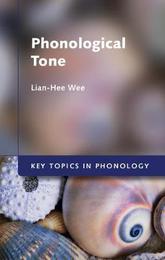
|
Phonological Tone
Hardback
Main Details
| Title |
Phonological Tone
|
| Authors and Contributors |
By (author) Lian-Hee Wee
|
| Series | Key Topics in Phonology |
|---|
| Physical Properties |
| Format:Hardback | | Pages:342 | | Dimensions(mm): Height 223,Width 142 |
|
| Category/Genre | linguistics
Phonetics and phonology |
|---|
| ISBN/Barcode |
9781107125728
|
| Classifications | Dewey:414 |
|---|
| Audience | | Professional & Vocational | |
|---|
|
Publishing Details |
| Publisher |
Cambridge University Press
|
| Imprint |
Cambridge University Press
|
| Publication Date |
28 February 2019 |
| Publication Country |
United Kingdom
|
Description
From the physiology and acoustics to their patterning across human languages, tone is one of the fundamental constructs in human languages that is also among the hardest to apprehend. Drawing upon a large number of languages around the world, this volume explores the concept of tone starting from its physical properties of articulation and acoustics to its manifestation in phonology. Designed as a comprehensive study accessible to the novice and useful for the expert, each chapter covers a particular aspect of tone in increasing depth and complexity, weaving together key concepts and theories that provide complementing or competing accounts of tone's phonological intricacies. In the process, one uncovers the underlying laws and principles that inform today's understanding of the subject to form a more synthesized view that also allows us to explore the relation of tone to other important areas of humanity such as literature, history, music and cognition.
Author Biography
Lian-Hee Wee is professor and associate dean of arts at the Hong Kong Baptist University. His research focuses on Chinese languages and Asian Englishes, contributing to phonological theorizing grounded in field and laboratory data, with extensions to music and poetry.
Reviews'This amazing book does justice to the diversity among tone languages, first by covering the basics of the phonetics and phonology of tone and then by analyzing scores of examples drawn from languages from across the globe showing how tonal phenomena function. The final chapter on cognitive aspects is a bonus rarely found in a phonology textbook. It will interest linguists across a broad spectrum and is likely to give many instructors the push they need to offer a course in tone at the graduate and advanced undergraduate level.' William R. Leben, Stanford University, California
|